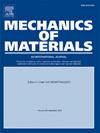Fully implicit crystal plasticity models representing orientations with modified Rodrigues parameters
IF 3.4
3区 材料科学
Q2 MATERIALS SCIENCE, MULTIDISCIPLINARY
引用次数: 0
Abstract
This work describes a crystal plasticity formulation combining several mathematical, numerical, and implementation choices to produce a highly efficient model. Specifically, the key choices in the implementation are (1) representing orientations with modified Rodrigues parameters, (2) implementing a fully coupled implicit time integration for the elastic stretch, the crystal orientations, and the model internal variables, (3) implementing the model in the NEML2 constitutive modeling framework, based on PyTorch, to vectorize the calculations and port the computation to GPUs and other hardware accelerators, and (4) an exact implementation of the consistent tangent matrix, even for arbitrary coupling to other field variables beyond the displacements, like temperature, neutron fluence, etc. The first two features of the model are, to our knowledge, novel. The paper considers each of these choices individually as well as the final model as a whole. This includes a full description of modified Rodrigues parameters, their advantages over other representations of orientations, the mathematical formulae and tools required to implement a model with modified Rodrigues parameters, and a detailed description of the geometry of the space of modified Rodrigues parameters (in an appendix). It also includes a description of a fully implicit time integration scheme for the orientations and the advantages in representing orientations with modified Rodrigues parameters in implementing such a model. The work then assess, via numerical examples, the advantages of fully coupled implicit time integration versus more common decoupled and explicit time integration schemes. These studies demonstrate the computational advantages of fully coupled integration versus other time integration algorithms, though the performance of the competing models depends on the complexity of the underlying single crystal model. The study concludes by demonstrating that the choice of time integration method affects the sharpness of the predicted texture, with explicit methods for integrating the orientations overestimating texture sharpness and implicit methods underestimating texture sharpness.
完全隐式晶体塑性模型表示取向与修改罗德里格斯参数
这项工作描述了一个晶体塑性公式,结合了几个数学,数值和实现选择,以产生一个高效的模型。具体来说,实现中的关键选择是:(1)用修改的Rodrigues参数表示方向;(2)对弹性拉伸、晶体方向和模型内部变量实现完全耦合的隐式时间积分;(3)在基于PyTorch的NEML2本构建模框架中实现模型,将计算矢量化并将计算移植到gpu和其他硬件加速器上。(4)一致切矩阵的精确实现,即使是与位移以外的其他场变量(如温度、中子通量等)的任意耦合。据我们所知,该模型的前两个特征是新颖的。本文考虑了每一个选择单独以及最终模型作为一个整体。这包括对修改后的Rodrigues参数的完整描述,它们相对于其他方向表示的优势,实现带有修改后的Rodrigues参数的模型所需的数学公式和工具,以及修改后的Rodrigues参数空间的几何结构的详细描述(在附录中)。它还包括对方向的完全隐式时间积分方案的描述,以及在实现这种模型时用修改的Rodrigues参数表示方向的优势。然后,通过数值例子评估了完全耦合隐式时间积分与更常见的解耦和显式时间积分方案的优势。这些研究证明了完全耦合积分相对于其他时间积分算法的计算优势,尽管竞争模型的性能取决于底层单晶模型的复杂性。研究表明,时间积分方法的选择会影响预测纹理的清晰度,显式方法对纹理的方向进行积分,显式方法对纹理的清晰度估计过高,隐式方法对纹理的清晰度估计过低。
本文章由计算机程序翻译,如有差异,请以英文原文为准。
求助全文
约1分钟内获得全文
求助全文
来源期刊

Mechanics of Materials
工程技术-材料科学:综合
CiteScore
7.60
自引率
5.10%
发文量
243
审稿时长
46 days
期刊介绍:
Mechanics of Materials is a forum for original scientific research on the flow, fracture, and general constitutive behavior of geophysical, geotechnical and technological materials, with balanced coverage of advanced technological and natural materials, with balanced coverage of theoretical, experimental, and field investigations. Of special concern are macroscopic predictions based on microscopic models, identification of microscopic structures from limited overall macroscopic data, experimental and field results that lead to fundamental understanding of the behavior of materials, and coordinated experimental and analytical investigations that culminate in theories with predictive quality.
 求助内容:
求助内容: 应助结果提醒方式:
应助结果提醒方式:


